Since its establishment, the Hungarian Reformed Church has experienced dramatic and turbulent times, but it has always been a source of inspiration for Hungary.
The founders of the Hungarian Reformed Church bravely faced opposition and tribulation for their revolutionary ideas. Its heroes, some of them persecuted as galley slaves, were a great example of faith in times of trial. Literature, music and visual arts inspired by the Reformed faith represent a special feature of Hungarian art history. Throughout the centuries, Reformed ministers, politicians, artists and students have shaped Hungarian thinking and philosophy, contributing a genuinly unique colour to the diversity of Hungary.
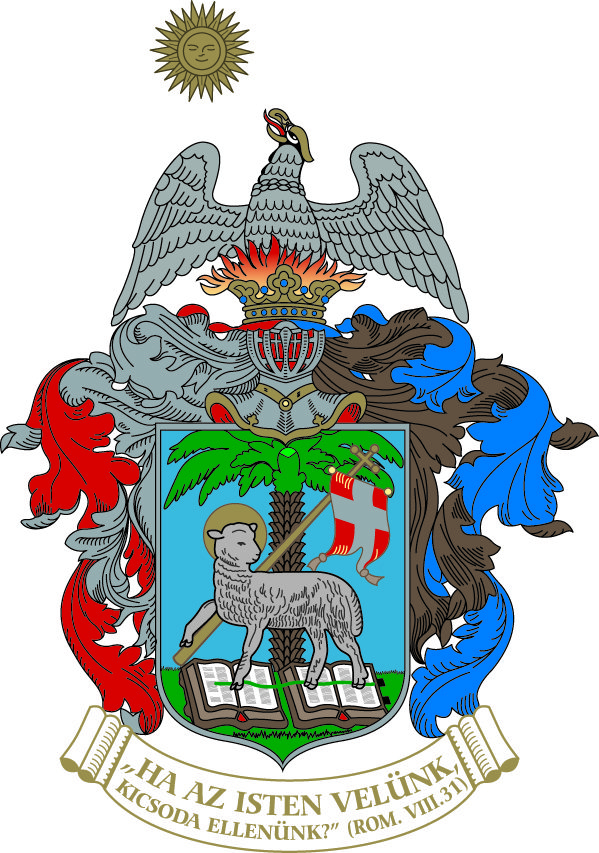
Crest – Coat of Arms of the RCH
The central figure of the crest is the Paschal Lamb, which represents Jesus Christ. The Lamb holds a flag with his right leg, which symbolizes the Helvetic Confessions. The two books upon which the Lamb is standing represent the Old and New Testaments. The palm tree in the center symbolizes the motif of the Tree of Life, and it also represents the solidity and the capacity of resistance, and the history: the Church stood in destructible wars as an oasis in the desert. The phoenix represents the allegory of the fateful hardships of rebirth from its ashes. The Sun is the symbol of immortality and power. In addition, the biblical words of the Reformation are included:“If God is for us, who can be against us?” (Romans 8:31)
The new "German religion" – Reformation in the 16th century
Lutheran ideas spread in Hungary shortly after Luther nailed his theses on the gate of the Wittenberg Castle Church. German merchants brought the evangelical ideas from the Holy Roman Empire to the German-speaking citizens of Hungarian cities. The early Reformation even produced followers in the royal palace of Buda through Johannes Henckel, the court priest of the Queen Mary of Habsburg.
At first, the Hungarian lower nobility was suspicious of the Reformation. They considered it a German thing, a new "German religion," as they labeled it. They issued edicts against the Lutherans as early as 1521 when the edict of the Rákos National Assembly declared – "lutherani comburantur" – "the Lutherans must be burned at the stake."
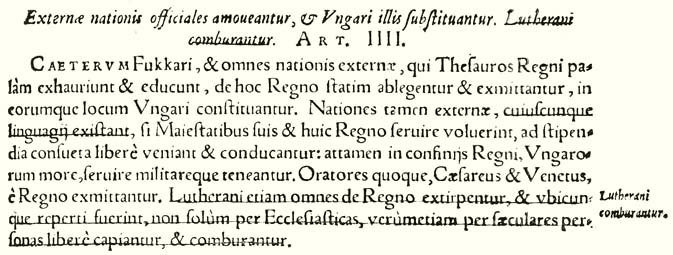
Edict of the Rákos National Assembly
The petty nobles also saw a divisive element in the Reformation, which divided Christianity, despite the threat of the Ottoman Turks. Surprisingly, the 150-year-long Turkish occupation of Hungary boosted the spreading of the Reformation in Hungary.
In 1526,Hungary suffered a horrendous defeat from the Turks at the Battle of Mohács. Two decades after Mohács, Hungary was divided into three parts. The Northwest came under Habsburg rule. From then on the Habsburg Emperors were crowned also as Kings of Hungary. The eastern part of the kingdom, under the name Transylvania, initially became an independent principality but gradually was brought under Turkish rule as a vassal state of the Ottoman Empire. The remaining central area (most of present-day Hungary), including the capital of Buda, became a province of the Ottoman Empire.
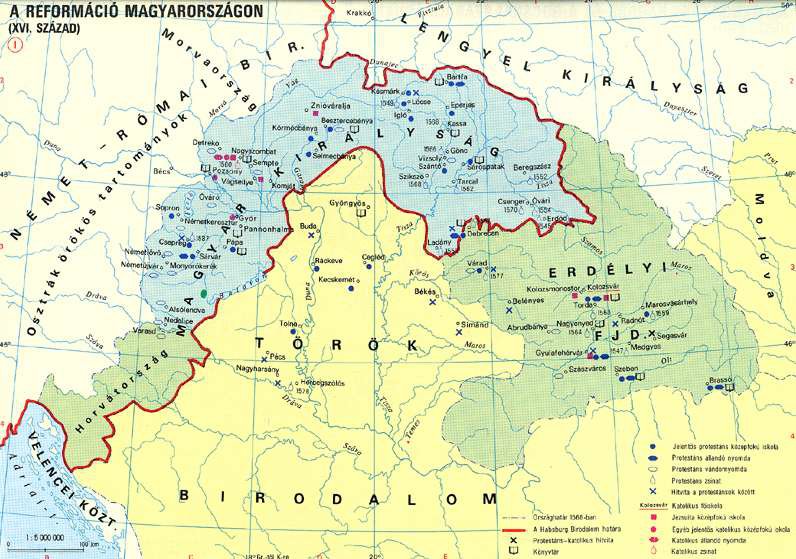
Reformation in Hungary in the 16th century
Reformation during the Turkish occupation – unobstructed spreading
This national disaster, the loss of the free Hungarian state, and the everyday threat of looting Turkish hordes prepared the Hungarians to embrace the evangelical message of the Reformation. Evangelical preachers – mostly former Franciscan monks such as Mátyás Dévai Biró and Mihály Sztárai —wandered the countryside, spreading the gospel and Reformed ideas to the desperate common people of the occupied territories.
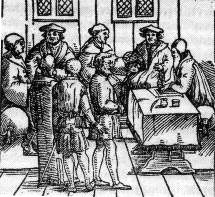
Mátyás Dévai Bíró in front of his judges
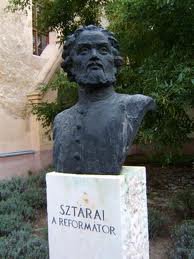
Statue of Sztárai Mihály in the courtyard of the Reformed Church in Nagyharsány
Local parishes joined the Reformation, statues and pictures were removed from church buildings and the local priests either embraced the Reformation or were expelled and replaced by Reformed preachers.
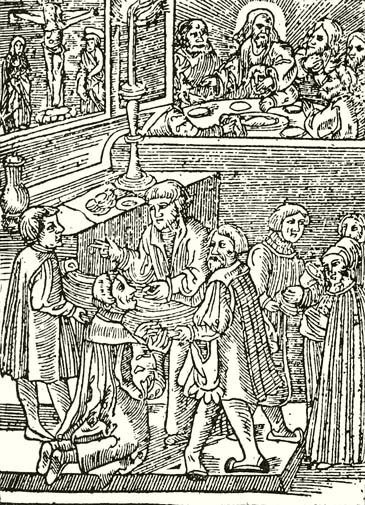
Xylograph from the Heltai Catechism from 1550, illustrating Holy Communion
The Turks did not urge Muslim conversion among the newly conquered Hungarians and did not care about religious divisions among Christians. From their viewpoint, all Christianity was paganism, although they were more sympathetic towards the Protestants because of their white-walled churches, simple worship services, and the absence of statues and pictures.
Reformation thus spread through the Turkish-occupied territories and in the Principality of Transylvania without any obstacles. Only in the Habsburg-ruled Western Hungary was this process halted by the Empire's strong counter-Reformation policy. Around this time (the end of the 16th century), according to certain sources, almost 95% of the Hungarian population became Protestant, mostly Calvinist.
Institutional foundations – Calvinism and culture
The Hungarian nobles were still suspicious of Lutheranism because of its German origins. This could be the reason why the Swiss wing of Reformation, especially Calvinism, was more favoured and popular in Hungary than Lutheranism. Free from their Catholic overlords, the Hungarian Protestants of the Turkish-occupied lands could organise their own ecclesiastical system. Constitutional synods were held for the Lutherans in 1545 in Erdőd, and for the Calvinists in Csenger in 1557. Most importantly, a Reformed Synod was held in 1567 in Debrecen, the central hub of Hungarian Calvinism, also known as the Rome of Calvinism, where the Second Helvetic Confession was adopted as the official confession of Hungarian Calvinists.
Meanwhile, the Principality of Transylvania became a pioneer of religious freedom; in 1568 the Transylvanian Diet of Torda declared, "It is not allowed for anyone to intimidate anyone else with captivity or exile for their religion."
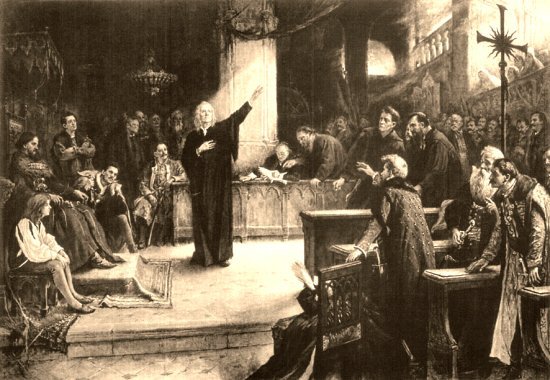
Transylvanian Diet of Torda, painting of Aladár Körösfői-Kriesch
Four religions were declared accepted (recepta) religions: Roman Catholic, Lutheran, Calvinist and Unitarian. Later, in the 17th century Transylvania became an internationally recognized Protestant state, and the Transylvanian princes – such as the Calvinist Gábor Bethlen – led several military campaigns against the Habsburgs to preserve the equal rights of Protestants in Habsburg Hungary and Transylvania.
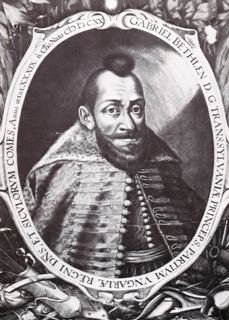
Line- engraving of Gábor Bethlen
Protestants also endorsed the development of Hungarian culture. Schools and colleges were founded according to the spirit of Reformation. The fundamentals of the contemporary Hungarian literary language were established by the first Hungarian Bible translation, translated by the Reformed dean Károli Gáspár.
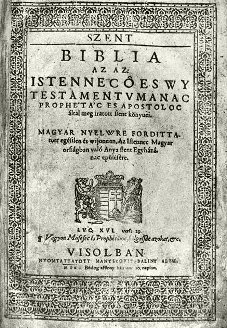
The cover of the first Hungarian Bible translation, which was published in Vizsoly
The Habsburg rule – aggressive counter-Reformation and re-Catholicisation in the 17th century
On the eve of the 18th Century, all of Hungary was gradually liberated from the Turks by a pan-European alliance led by the Habsburgs. However, the liberators stayed in power, so after the 150-year-long Turkish occupation, Hungary became one of the many countries of the Habsburg Emperors. Transylvania became part of Hungary again, and the Habsburg Emperors started to exercise their aggressive counter-Reformation policy on the liberated territories with effective help from the Jesuit Order. Their primary method was the re-Catholicisation of Hungarian aristocracy by promising promotions and well-paid offices in the royal court. They also founded seminaries and schools to increase the numbers and influence of the Catholic intellectuals. However, they were not afraid of employing suppressive methods to achieve their goals.
The symbolic highpoint of Hungarian counter-Reformation was the seating of the so-called "Bloody Court of Pozsony." In 1673, more than 400 Protestant pastors and teachers were summoned to the imperial court in Pozsony (Bratislava). Because of their Reformed belief, they were accused of high treason and given the choice of either becoming Catholics or fleeing the country.
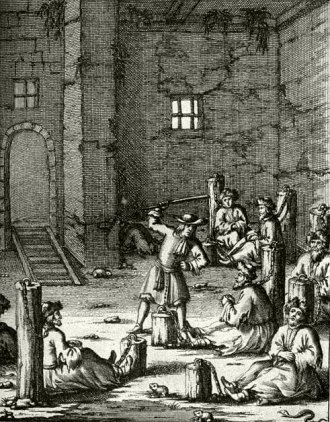
Protestant pastors in prison
Some of them became Catholics, many of them fled abroad, but around forty remained faithful. They were imprisoned and tortured, then sold as galley slaves on the Mediterranean Sea. Only thirty of them survived in the galleys. The Dutch Navy, under the leadership of admiral De Ruyter, freed them in 1676.
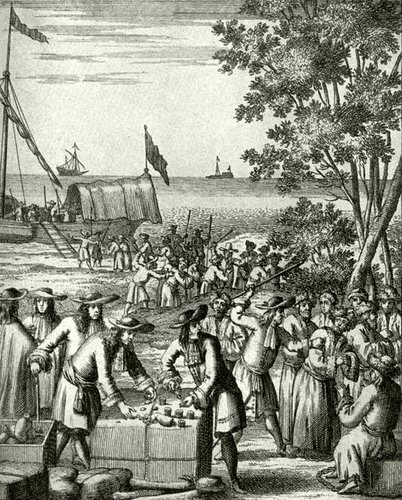
Galley slaves, engraving from the Low Countries, 1684
Consequently, in the third part of the 17th century and in most of the 18th century, under the rule of Charles III and his daughter Maria-Theresa, Hungarian Protestants were viewed as second-rank citizens in Hungary. Imperial edicts, such as the Resolutio Carolina of 1731, settled the status of Protestant churches by always deciding in favour of the ruling Catholic side. Protestants were allowed public exercise of their religion only in the western districts of the country – everywhere else, they could only exercise their religion privately. Protestants were not permitted to hold public offices, and Protestant ministers were forbidden to live outside the places legally designated to them.
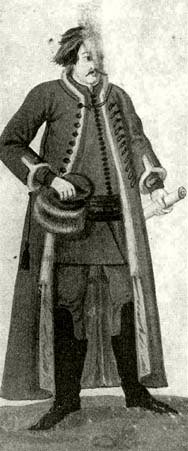
Reformed Pastor in the 17th century
Marriage matters of Protestant families were placed under the control of the local Catholic bishop. Regarding mixed marriages – marriage between a Protestant and a Catholic party – it was enacted that the marriage must be made before a Catholic priest and the children must be brought up in the Catholic faith.
As a result of this counter-Reformation policy and the immigration of German Catholic settlers, the Catholic population rapidly increased, so much that in 1805 there were around 5 million Catholics to 2 million Protestants in Hungary.
Rights and freedom step by step – Edict of Toleration, emancipation and the birth of the modern Hungarian Reformed Church
Only the end of the 18th century brought some relief to the Hungarian Reformed Church. In 1781, Joseph II's Edict of Toleration annulled the Resolutio Carolina. The Edict written in the spirit of the Enlightenment, declared that wherever there were one hundred Protestant families, they could freely exercise their religion and build churches without steeples or bells. Protestants were also permitted to hold public offices and were released from celebrating the Catholic feast days. Protestant marriage matters were placed under the control of secular courts. Children of a mixed marriage were to be brought up as Catholics only when the father was a Catholic, if he was not, then only the daughters were to be Catholic.
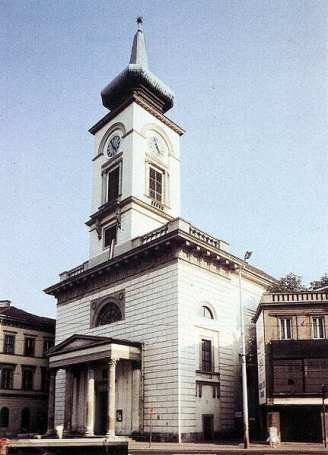
Reformed Church in Kalvin Square in 1830
From the time of the Edict of Toleration, the regulation of mixed marriages became milder and milder, and the Protestants received more and more rights. The failure of the 1848 revolution halted this process for almost two decades (Protestant Patent of 1860), but finally the 1867 compromise between Hungary and Austria, which established the Austro-Hungarian Monarchy, gave free way for the emancipation of Hungarian Protestants. The process resulted in the ecclesiastical bills of 1894-95, which essentially, provided equal rights to Protestant churches.
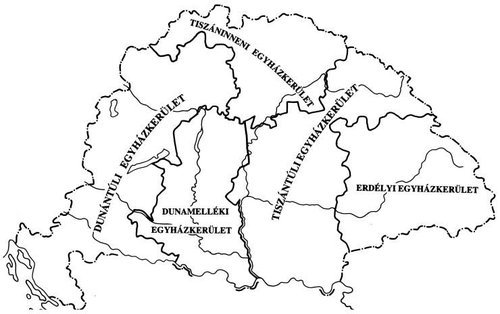
Church district in the 19th century
This era also allowed the possibility for the constitutional reorganization of the Hungarian Reformed Church. In 1881, for the first time in an almost 400-year-long history, the four Hungarian Reformed Church Districts (Transdanubian, Danube Area, Transtibiscan, and Cistibiscan) together with the Transylvanian Reformed Church held a united Synod meeting in the city of Debrecen. The modern Hungarian Reformed Church was born there at the Debrecen Synod of 1881. Of course, there were a lot of constitutional changes, especially during and after the Communist Dictatorship, but the inner hierarchy and the synodal-presbyterian system of the Reformed Church remained nearly unchanged from that time.
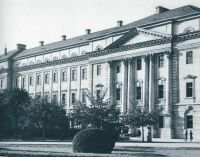
Collegium in Debrecen in the 19th century
The long 20th century - struggles and difficulties
After the Austro-Hungarian Monarchy lost World War I, the Peace Treaty of Trianon in 1920 significantly altered the shape of the Hungarian Reformed Church. The Peace Treaty cut off two-thirds of Hungary's territories. Consequently, many Hungarian Reformed people now live in the surrounding countries. According to the 1910 Census, around 2.5 (2,621,329) million Reformed people lived in the five Hungarian Reformed Church Districts at that time. With the Treaty of Trianon, the number of Reformed people in Hungary dropped by almost 1 million (916,906).
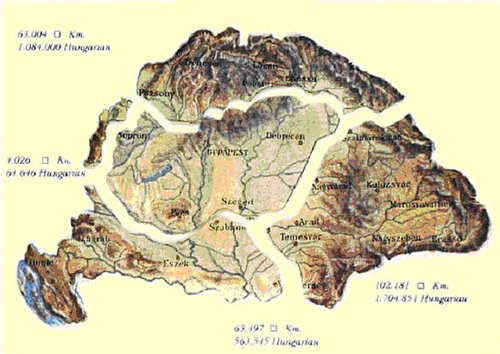
The map shows how the Trianon Peace Treaty cut off two-thirds of Hungary's territories
Another big tribulation came to the Hungarian Reformed Church with the Communist Dictatorship following World War II. After the confiscation of church estates, schools and institutions, the Communist government forced the Reformed Church to sign an agreement with the state on the 7th of October 1948. The text of the Agreement was not too disadvantageous under the circumstances; the problem was that the state had never intended to abide by. Practically, it became a pretext to harass the Church, interfere with Church activities and bring all the work and personnel of the Church under the control of the state and Communist Party. State influence was achieved by the direct control of Church leaders and the State Office for Church Affairs, whose agents infiltrated every level of church government. They maintained a network of secret informants who reported on the doings of pastors, congregations and their individual church members. Religious organizations were abolished, and those who did not want to obey the new establishment were persecuted or imprisoned; some of them were even executed. By this policy the Communist State made the Reformed Church's cultural, social, and most importantly evangelical mission to the people almost impossible.
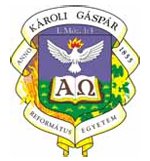
Coat of arms of Károli Gáspár University of RCH
Only the political changes of the 1990s brought relief to the churches. After that, a "free church in free state" model was adopted. The Reformed Church, similar to other Hungarian Churches, regained many of its confiscated properties. Many of the abolished missionary organizations were restored, many of the closed schools were reopened, and what is more, a number of new schools, high schools and even a new Reformed university, the Károli University, were founded since then. The forty years of Communist rule meant a significant setback for the Hungarian churches, but now, hopefully, under the new circumstances the Reformed Church can freely continue its God-given mission to the Hungarian people.
Historical timeline
For our timeline, we divided the periods of our church's history and lined up important dates and events from the Reformation until the present.
1517 - Luther nails his "95 Theses" on the church door in Wittenberg on October 31st.
Part of Luther's 95 Theses
1521–1525 Anti-Protestant edicts of the Hungarian National Assembly
1526 – The Hungarian Kingdom suffers a crucial defeat from the Ottoman Turks at Mohács. The lack of central government boosts the spread of the Reformation.
1531 – The founding of the Reformed colleges of Pápa and Sárospatak
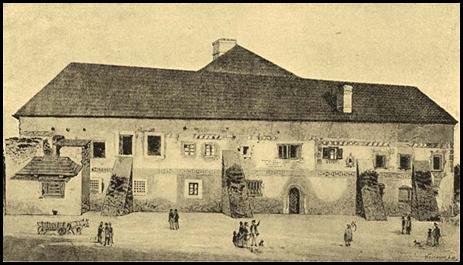
Reformed College in Sárospatak
1538 – The College of Debrecen is founded
1541 – János Sylvester translates the New Testament into Hungarian
1541 – Buda, the Hungarian Capital, is conquered by the Turks. Hungary separates into three parts (Royal Hungary ruled by the Habsburgs, territories occupied by the Ottomans, Principality of Transylvania)
1567 – Constitutional Synod of the Transtibiscan Church District in Debrecen
1568 – The Transylvanian Diet of Torda declares religious toleration; four denominations are accepted (recepta) religions: Roman Catholic, Lutheran, Calvinist and Unitarian.
1576 – The Constitutional Synod of the Danubian Church District in Hercegszőllős
1590 – Gáspár Károli translates the Bible into Hungarian
1591 – Dispute of Csepreg – the first clashes between Lutherans and Calvinists in Hungary, separation into two denominations
1606 - Albert Szenczi Molnár translates the Genevan Psalter into Hungarian
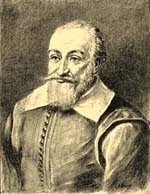
Portrait of Albert Szenci Molnár
1607 – Albert Szenczi Molnár translates the Heidelberg Catechism into Hungarian
1612 – The Constitutional Synod of the Trans-Danubian Church District in Köveskút
1616-18 – Forming of the first session (council of church elders) in Pápa, Trans-Danubia
1646 – The "National" Synod of Szatmárnémeti theoretically agrees with the introduction of the sessions but postpones their declaration "until the Church populace becomes mature enough to rule themselves"
1653 – János Apáczai Csere publishes the Hungarian Encyclopaedia, proving the advanced state of Hungarian Reformed scholarship
1671-1681 – The "Decade of Mourning" – aggressive counter-Reformation policies of the Habsburgs on the liberated Hungarian territories
1673 – The "Bloody Court of Pozsony" – Protestant pastors sentenced to galley slavery in Naples
1676 – The Dutch Admiral Ruyter frees the enslaved Hungarian pastors from the Neapolitan galleys
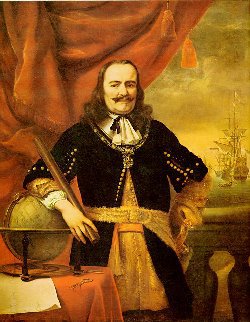
The Dutch Admiral Ruyter
1686 – Buda liberated by the Habsburg-led Christian coalition
1731 - Resolutio Carolina – anti-Protestant edict of Emperor Charles VI.
1781 – Edict of Toleration by Emperor Joseph II
1848 – The April Laws of the 1848 Revolution declare equality between the accepted denominations (Catholic, Reformed, Lutheran, Orthodox, Unitarian)
1860 – Protestant Patent – coerced constitution of the Protestant churches by the Austrian government after the defeat of the 1848 Revolution
1867 – Compromise between Hungary and Austria, founding of the Austro-Hungarian Monarchy
1881 –Synod of Debrecen – forming of the modern church constitution of the Hungarian Reformed Church
1920 – The Trianon Peace Treaty cuts off two-thirds of Hungary's Reformed population (from 2.5 million to around 1 million)
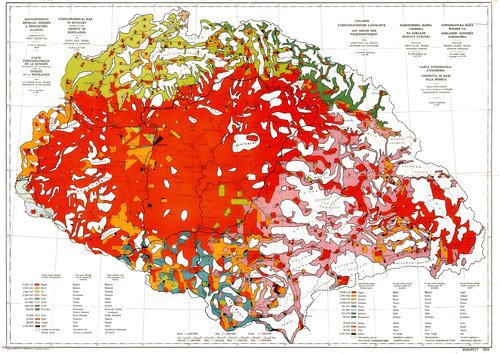
Carte Rouge; the map made by Teleki, which shows how many Hungarian people lived in the Carpathians in 1920 (red: Hungarian, orange: German, light green: Slovakian, pink: Romanian, dark green: Serbian, grey: Croatian)
1948 – Coerced agreement with the Communist State, beginning the secularization of Church-schools and properties
1990 – After the fall of socialism, the churches experience new freedom. Many secularised church schools and properties are given back
2009 May 22 - Constituting Synod in Debrecen, which established the Hungarian Reformed Church as a community of Reformed churches in the Carpathian Basin
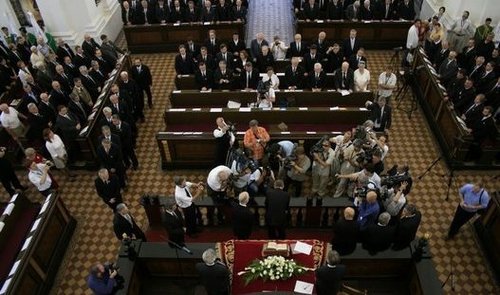
Signing of the constitution of the Hungarian Reformed Church
Brochure
The Hungarian Reformed Community in the Carpathian Basin and around the world
Broschüre
Die ungarische reformierte Gemeinschaft im Karpatenbecken und in der ganzen Welt